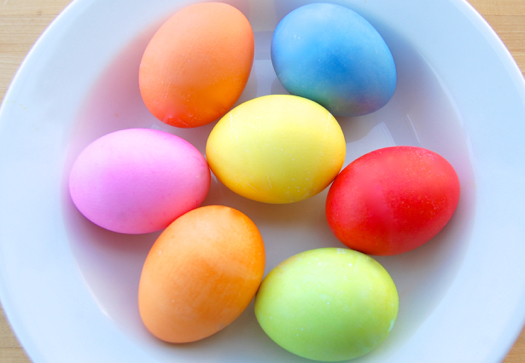On Easter Eggs

Eggs are a conspicuous part of an Italian Easter bread, and for Greek Easter bread as well as reader Rick reminds me. The two are virtually identical save for the fact that in the Greek version the eggs are all dyed a single color: a deep crimson red. That’s standard for Greek Orthodox Catholics, being a bit more doctrinaire than most Roman Catholics. I guess they don’t call it “Orthodox” for nothing.
In the orthodox tradition Easter eggs are always dyed blood red to symbolize the drops of blood shed by Christ on the cross. Roman Catholics, like other Christians who celebrate Easter, tend to approach Easter eggs with a bit more frivolity. Ours come in all colors of course, they can be tie-dyed, drawn upon, you name it.
These days most of us don’t think much about the symbolism, which is fundamentally that of rebirth. You can take that literally in the sense of a new chick continuing the cycle of life, or more metaphorically in the sense of a seemingly inanimate object — something “dead” — coming to life. In some traditions the egg represents the tomb where the apostles placed the body of Jesus after the crucification, in others it’s the stone that was rolled across the tomb door. You can go in a lot of directions with something as elemental as an egg.
But the egg is of a piece with the whole “rebirth” theme of the season. Chickens start to lay eggs again in the spring after a winter hiatus. Undomesticated birds do as well. Not coincidentally, rabbits and hares produce their largest litters in the early spring, which is where the Easter bunny comes into the picture. As you might expect, The Bunny is a relatively late comer on the Easter scene. Originally a hare that served a function not unlike Santa Claus, he was invented by German Lutherans in the middle 1600’s.
My mom learned to make Easter eggs from some Ukrainian grandmas and for a few years we had a bunch of those around the house. They were not for eating though, more objet d’art. Its a great process & I have thought about trying it but never have,
Wonder what the Orthodox would think of them, they may have red on them along with a dozen other colors.
Ukrainian eggs are the most beautiful in the world in my opinion. I have no idea how they’re made but would love to see the process sometime.
YouTube here I come!
Cheers,
– Joe
the process is amazingly simple, mastering it is another story. You have to have this tiny metal funnel, called a kiska. It has just a pinhole really on the end of a wooden stick. You fill the funnel with wax & heat it till it starts running out the end. Draw anything you want white with the wax coming out of the funnel. When done put the egg in yellow dye. Then repeat the waxing this time covering everything you want to stay yellow. Repeat the process using the next darkest color each time. When you have gotten to black you are done, warm the egg and rub the wax off.
When you see how it is done it makes the intricate, delicate, designs even more amazing.
That sounds like fun, Frankly. And it makes a lot of sense. I’m not sure I could plan a design like that, but maybe with practice. The Joe logo on an Easter egg next year? Why not?
– J
Last week at the Ukrainian Museum in the East Village they had a display of Easter eggs (stunning) as well as some people making them, so I went to watch the process. They use beeswax to draw the patterns onto the eggs and then dip the eggs into different colored dyes, from lightest to darkest colors, waxing the parts that they want to remain a particular color. (It’s not unlike batik.) It was an amazing process to watch, and the designs are so intricate and beautiful.
My third grade teacher taught our whole class how to make pysanky eggs and we all went home with a full kit with three kistki, beeswax and dye set. It’s a painstaking process that requires a lot of patience from picking out the smoothest, best shaped eggs in the grocery store to drawing patterns on the eggs with beeswax and then soaking in the dyes (repeated as needed) to the final reveal of melting away all the beeswax bit by bit and wiping it off with a piece of old tshirt (polyurethane final coat optional). But totally worth the time and effort! A slightly OCD personality is helpful to making it through the whole process successfully. 🙂
That’s me, Deb, no question. Clearly I need to try this.
Hope you had a great Easter!
– Joe